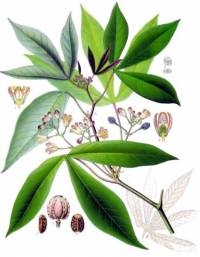Cassava
| Botanical Information |
| Order | Malpighiales |
| Family | Euphorbiaceae |
| Genus | Manihot |
| Common Name | Cassava |
| Species | M. esculenta |
Maturity days
Planting Months
| Planting months |
| Jan | Feb | Mar | Apr | May | Jun | Jul | Aug | Sep | Oct | Nov | Dec |
| | | | X | X | X | X | X | | | | |
Permaculture uses
| Permaculture uses |
| Usage 1 | Usage 2 | Usage 3 |
| Pioneer | Starch | Vegetable |
| Growing Condition | Comment |
| Drought Tolerant | Yes |
| Humidity tolerant | Yes |
| Planting area | Ground |
| Sunlight | Full_sun |
Photos
Woody shrub. Tubers/Leaves poisonous. Must be boiled before consumption. Can be used as fencing
PLANT DESCRIPTION A large, 3-4 m high, tropical woody shrub with enlarged tuberous roots. It tends to branch irregularly and bears its large (20 cm long) lobed leaves near the tips of long branches. The leaves are short-lived (1-3 months) and are readily lost during drought or after insect attack. Cassava is very hardy and tolerant of a wide range of soils. USES Leaves for consumption can be produced throughout the year if the plants receive sufficient water. The portion eaten is generally the maturing leaves that are just reaching full size. Cassava leaves are NOT EATEN RAW, as they contain harmful glucosides which release deadly hydrocyanic acid. To dispel the poison the leaves must be boiled at least 15 minutes. Cassava leaves contain protein, iron and B vitamins. They are boiled like spinach or added to stews. There are so many useful and easy to grow tropical greens that cassava leaves are not a 'first choice' option. Sweet potato leaves, pumpkin tips, kangkong, ceylon spinach are better alternatives and are easy to eat and prepare. The roots are more useful as a food plant, they are harvested when the leaves begin to yellow and fall. They are eaten boiled, fried, baked and made into flour. The refined starch from the tubers, known as tapioca pearls, is used in soups, puddings and dumplings. The roots store well. PLANTING DETAILS Recommended Planting Time: All year in the tropics, during the warmer months in the subtropics. Growing Details: Woody cuttings are planted upright in the soil with the sloping end up. Cutting the tops of the cuttings at an angle stops water sitting there and reduces problems with rot. The best cutting material is obtained from plants at least 10 months old, 2.5 to 4 cm thick and about 20 - 30 cm long, with a minimum of 3-6 buds per cutting. The cuttings are buried to half their length, aiming to have several buds under the soil. The cuttings root readily and establish plants within 2 months. Place plants 80 to 140 cm apart.

